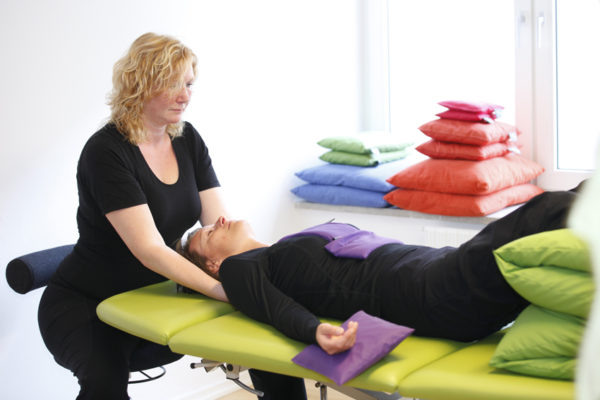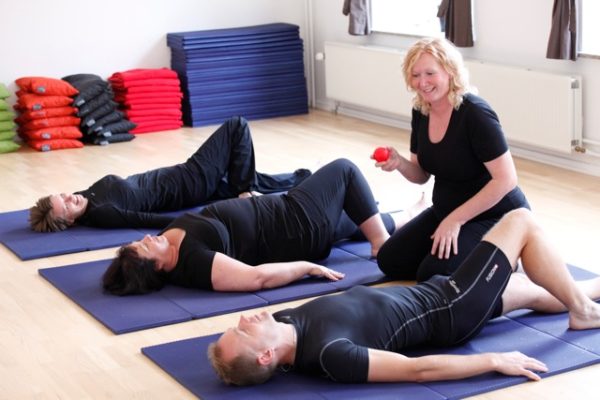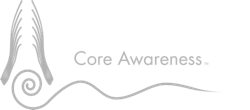Lene Guldbech Uttrup is a Danish psychomotor therapist working with body awareness, sensory integration, and stress reduction. She is the owner of the CoreTools™ series (www.coretools.dk ) of balls and rollers that I use in all my workshops. Lene introduced me to her colleagues in Copenhagen in 2009. She has studied with me in Warwickshire England, Ojo Mexico, attended my professional trainings twice, and completed my advanced course for professionals. Lene is a vital part of my community and has continued to support my work not only by sponsoring workshops in Denmark but also by assisting in the organization of incredible retreat settings for my advanced course for professionals.
Please tell our readers a little about the skin as an organ of perception, specifically the tactile experience and why is it so important for landing, orienting, and feeling safe?
 The tactile system begins developing in the sixth fetal week. As we grow in our mother’s womb space becomes increasingly restricted within the uterus. We are surrounded by soft pressure, especially during a vaginal birth when we are squeezed, pushed, and pressed through the birth canal to find ourselves outside, in a limitless world – where there is no longer soft pressure or containment. Being physically close to our caregivers normally provides the touch and sense of safety needed to serve, so to speak, as our extended womb. Through this skin contact well-being is triggered by the release of the hormone Oxytocin. Professor of Physiology Kerstin Uvnäs Moberg (Sweden) describes oxytocin as one of the brain’s most important substances in terms of both survival and healing. (Kerstin Uvnäs”, Afspænding, ro og berøring” Akademisk Forlag, 2006 / “Oxytocin Factor,”Pinto & Martin Ltd, 2. edition, 2011).
The tactile system begins developing in the sixth fetal week. As we grow in our mother’s womb space becomes increasingly restricted within the uterus. We are surrounded by soft pressure, especially during a vaginal birth when we are squeezed, pushed, and pressed through the birth canal to find ourselves outside, in a limitless world – where there is no longer soft pressure or containment. Being physically close to our caregivers normally provides the touch and sense of safety needed to serve, so to speak, as our extended womb. Through this skin contact well-being is triggered by the release of the hormone Oxytocin. Professor of Physiology Kerstin Uvnäs Moberg (Sweden) describes oxytocin as one of the brain’s most important substances in terms of both survival and healing. (Kerstin Uvnäs”, Afspænding, ro og berøring” Akademisk Forlag, 2006 / “Oxytocin Factor,”Pinto & Martin Ltd, 2. edition, 2011).
The skin is our largest organ extending over approximately 2 m2, and serves, amongst other things, as a membrane. It is one of the first organs to receive messages from other people. In countries where there is a tradition of infant massage, using strokes, gentle pressure, squeezing, bending, and stretching, babies gain a sense of their own boundaries. Touch that is tuned to fit a baby’s needs releases oxytocin, calming and building trust. When touch is missing or out of sync with a baby’s needs, however, an infant may become anxious and restless activating a protective system that triggers warding off responses which increase muscle tonus. Our need for touch is with us our whole life, especially when we are feeling “lost”. In Denmark there is a growing awareness of “hudsult”, which can be translated to “skin hunger”. When we are not touched enough we can become disoriented. There are a thousand nuances to touch, so I collaborate with each of my clients to find out how they need their touch to be in order that they can “locate” and find themselves in their own skin.

How do the tools that you employ support proprioception, sense of self, and creativity? How do you like to use these tools?
I got involved in developing my own tools because I did not like the tools that were available in the marketplace. I felt they were too hard and that they left me with too few options for leaning into my sensation. I wanted to be the one in charge of when my exploration stopped rather than have it determined by the hardness of the tool being used. I also wanted to increase movement, not my sense of restriction. The hardness of the tools available annoyed me so much that I began to develop the CoreTools™ series of rollers and balls. Very important to me is that these tools are produced with EU standards that follow strict regulations and rules and contain no phthalates (or BPA). I started with the roller I call Wake ‘n Move, which is designed to wake up the receptors of the tactile system and inspire movement. It is soft yet has a bite to it. The more air you add, the more bite it has. I like that the user can customize the tool to meet his or her needs, which is what these tool are all about! The tool adjusts to your needs rather than you having to behave in a certain way to have your needs met.
I work primarily with touch using my hands but I also like using the tools with my clients because a tool can help a person stay focused on the process of finding “home.” Using the tool stimulates the tactile system. When clients learn to do this for themselves, it becomes a skill for life. For instance, stimulating the soles of the feet fires up the receptors in the muscles and joints not only in the feet but also all the way up to the top of the head. For clients with stress and excessive thoughts, focusing on only one thing at a time, such as maintaining balance by rolling on the Wake ‘n Move,or ball, is a gift. Working with one foot at a time offers a comparison that helps a client regain trust that change really can happen. After both feet have been rolled, my clients often feel calmer, more grounded, and connected to the earth. In addition, there is no one-way to use the tools or just one outcome. I tell my clients “it is your exploration and your sensory system, and the same tool or exploration might feel different tomorrow.” Change is a part of the process of getting to know your self better through sensory awareness.

As a somatic educator how do you incorporate somatics into your work with other people and for what reason? For those who may not know there is an amazing use of somatic education in the health and wellness community in Denmark that does not exist in the States or in many other countries.
As a psychomotor therapist, my work is all about building bridges between how a person feels physically and mentally. I stand with one leg in the natural science field and the other in the humanistic field. This means that I benefit from all of the knowledge related to human anatomy (all you can see with your bare eyes), the physiology (all you need a microscope to examine), and I benefit from all of the knowledge related to psychology and pedagogy. I work from a phenomenological point of view, which basically means that a person’s experience and preferences lead the way. As a professional, I have my knowledge in my back pocket, but I do not have a “one-size-fits-all” agenda. Clients come to me to learn about their body and their way of being present in life.
I work primarily with people with overactive nervous systems – people with stress or sensory processing imbalances. I work one on one and in small groups, as it can be very beneficial for people to learn about how other people experience an exploration or situation. I also educate foster parents about appropriate touch for their foster children, so that their touch can help heal early experiences these children carry with them. As a mother to a special needs child (a young man now), my work has proven its worth many times. My son was diagnosed with autism as well as ADHD and is sensitive to stimuli. Knowing how to calm the level of arousal present in his body or help him let go of his many thoughts has been such a fantastic way of staying present to myself and at the same time helping my nearest kin.

How and why has the psoas played an important part in your professional and personal life?
I find being in contact with my own psoas is essential for being authentic and present with my family and clients. The awareness of being present in me, rooted in me, helps me be a better psychomotor therapist. I came across Liz’s website in the early 2000s when I was still studying to become a psychomotor therapist. Her work made perfect sense to me. One has to be respectful towards the psoas. I sometimes compare improving psoas issues with trying to gain a timid child’s or animal’s trust. You have to be trustworthy and authentic. You have to be kind and patient. You have to let the information come to you and let go of any predetermined ideas of how and why. You also have to be able to simply be with the moment. For me, being aware of how my own psoas is responding helps me become a better somatic educator.
What have you gained from working with Liz Koch’s approach to the psoas?
I have attended many workshops with Liz, and I always learn something new. It is truly inspiring being with a person such as Liz, who never stops being curious and inventive.
